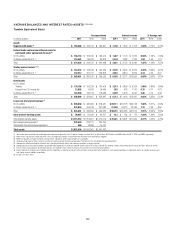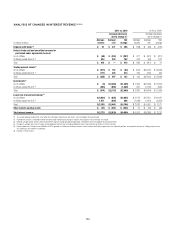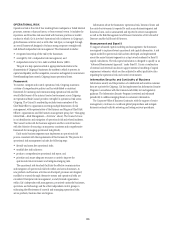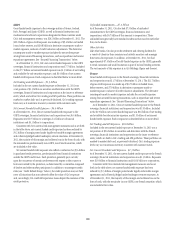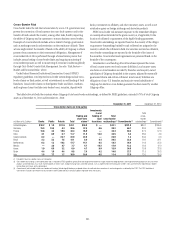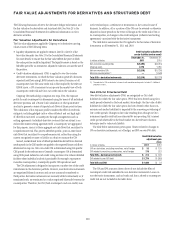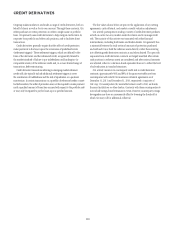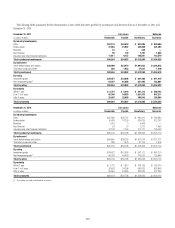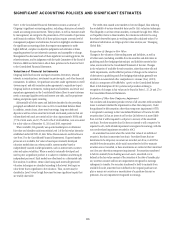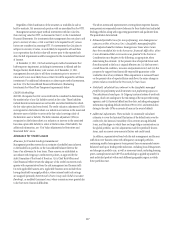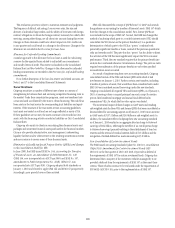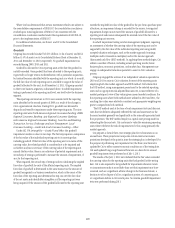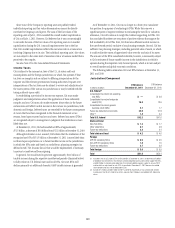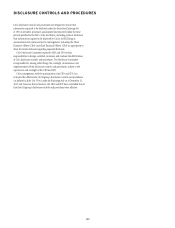Citibank 2011 Annual Report Download - page 134
Download and view the complete annual report
Please find page 134 of the 2011 Citibank annual report below. You can navigate through the pages in the report by either clicking on the pages listed below, or by using the keyword search tool below to find specific information within the annual report.112
Differences Between Country and Cross-Border Risk
As described in more detail in the sections above, there are significant
differences between the reporting of country risk and cross-border risk. A
general summary of the more significant differences is as follows:
Country risk is the risk that an event within a country will impair the
value of Citi’s franchise or adversely affect the ability of obligors within
the country to honor their obligations to Citi. Country risk reporting in
Citi’s internal risk management systems is based on the identification
of the country where the client relationship, taken as a whole, is most
directly exposed to the economic, financial, sociopolitical or legal risks.
Generally, country risk includes the benefit of margin received as well as
offsetting exposures and hedge positions. As such, country risk, which is
reported based on Citi’s internal risk management standards, measures
net exposure to a credit or market risk event.
Cross-border risk, as defined by the FFIEC, focuses on the potential
exposure if foreign governments take actions, such as enacting exchange
controls, that prevent the conversion of local currency to non-local
currency or restrict the remittance of funds outside the country. Unlike
country risk, FFIEC cross-border risk measures exposure to the immediate
obligors or counterparties domiciled in the given country or, if applicable,
by the location of collateral or guarantors of the legally binding
guarantees, generally without the benefit of margin received or hedge
positions, and recognizes offsetting exposures only for certain products.
The differences between the presentation of country risk and cross-border
risk can be substantial, including the identification of the country of risk,
as described above. In addition, some of the more significant differences by
product are described below:
For country risk, net derivative receivables are generally reported based
on fair value, netting receivables and payables under the same legally
binding netting agreement, and recognizing the benefit of margin
received and any hedge positions in place. For cross-border risk, these
items are also reported based on fair value and allow for netting of
receivables and payables if a legally binding netting agreement is in place,
but only with the same specific counterparty, and do not recognize the
benefit of margin received or hedges in place.
For country risk, secured financing transactions, such as repurchase
agreements and reverse repurchase agreements, as well as securities
loaned and borrowed, are reported based on the net credit exposure
arising from the transaction, which is typically small or zero given the
over-collateralized structure of these transactions. For cross-border risk,
reverse repurchase agreements and securities borrowed are reported based
on notional amounts and do not include the value of any collateral
received (repurchase agreements and securities loaned are not included in
cross-border risk reporting).
For country risk, loans are reported net of hedges and collateral pledged
under bankruptcy-remote structures. For cross-border risk, loans are
reported without taking hedges into account.
For country risk, securities in AFS and trading portfolios are reported on a
net basis, netting long positions against short positions. For cross-border
risk, securities in AFS and trading portfolios are not netted.
For country risk, credit default swaps (CDSs) are reported based on
the net notional amount of CDSs purchased and sold, assuming zero
recovery from the underlying entity, and adjusted for any mark-to-market
receivable or payable position. For cross-border risk, CDSs are included
based on the gross notional amount sold, and do not include any
offsetting purchased CDSs on the same underlying entity.
Venezuelan Operations
In 2003, the Venezuelan government enacted currency restrictions that
have restricted Citigroup’s ability to obtain U.S. dollars in Venezuela at the
official foreign currency rate. In May 2010, the government enacted new
laws that have closed the parallel foreign exchange market and established
a new foreign exchange market. Citigroup does not have access to U.S.
dollars in this new market. Citigroup uses the official rate to re-measure the
foreign currency transactions in the financial statements of its Venezuelan
operations, which have U.S. dollar functional currencies, into U.S. dollars.
At December 31, 2011 and 2010, Citigroup had net monetary assets in
its Venezuelan operations denominated in bolivars of approximately
$241 million and $200 million, respectively.


